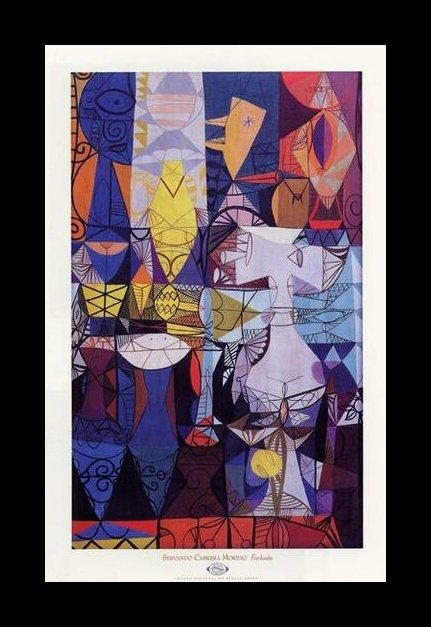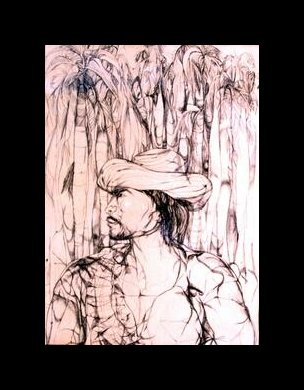Servando Cabrera Moreno (1923-1981)
Get a Cabrera Moreno Certificate of Authenticity for your painting (COA) for your Cabrera Moreno drawing.
For all your Cabrera Moreno artworks you need a Certificate of Authenticity (COA) in order to sell, to insure or to donate for a tax deduction.
Getting a Cabrera Moreno Certificate of Authenticity (COA) is easy. Just send us photos and dimensions and tell us what you know about the origin or history of your Cabrera Moreno painting or drawing.
If you want to sell your Cabrera Moreno painting or drawing use our selling services. We offer Cabrera Moreno selling help, selling advice, private treaty sales and full brokerage.
We have been authenticating Cabrera Moreno and issuing certificates of authenticity since 2002. We are recognized Cabrera Moreno experts and Cabrera Moreno certified appraisers. We issue COAs and appraisals for all Cabrera Moreno artworks.
Our Cabrera Moreno paintings and drawings authentications are accepted and respected worldwide.
Each COA is backed by in-depth research and analysis authentication reports.
The Cabrera Moreno certificates of authenticity we issue are based on solid, reliable and fully referenced art investigations, authentication research, analytical work and forensic studies.
We are available to examine your Cabrera Moreno painting or drawing anywhere in the world.
You will generally receive your certificates of authenticity and authentication report within two weeks. Some complicated cases with difficult to research Cabrera Moreno paintings or drawings take longer.
Our clients include Cabrera Moreno collectors, investors, tax authorities, insurance adjusters, appraisers, valuers, auctioneers, Federal agencies and many law firms.
We perform Servando Cabrera Moreno art authentication, appraisal, certificates of authenticity (COA), analysis, research, scientific tests, full art authentications. We will help you sell your Servando Cabrera Moreno or we will sell it for you.
Servando Cabrera Moreno has a uniquely different style than that of his Cuban contemporary artists. While others were finding their way in the world amongst the European schools of art, Cabrera Moreno found a different niche of his own. He found heightened popularity in Cuba throughout the 1960s and 70s, and his work is still revered today. Sometimes mythical, other times abstract, and towards the end of his career, more sexually explicit and erotic, Cabrera Moreno’s work is like no others of his time.
Born in Havana during the upswing of the vanguard movement, Cabrera Moreno studied art in New York City and Paris. He eventually came back to Cuba and graduated from the San Alejandro Academy, and had his first exhibition in 1943 at the mere age of 20. During his lifetime, he worked as a professor at the Cubanacan School of Arts, and lived for many years in Spain. He also showed his work at over 130 exhibits in his lifetime, leaving behind an extensive oeuvre of art.
While his subject matter often made him an outsider in the Cuban art world, his methods were not unusual. Watercolor, oil, gouache and pencil sketching were the main mediums that Cabrera Moreno used to create his art. His mediums may have remained constant, but his styles were always evolving.
In the beginning, Cabrera Moreno typically produced revolutionary themes, which was typical of Cuban artists at the time. However, his answer was through abstract art, such as “Abstraction” and “Fachada” (circa 1950s).

Abstraction

Fachada
While studying in New York, Cabrera Moreno was inspired by Pablo Picasso, which lead to his initial abstract style. One can clearly see the imprint that Picasso’s work left on him in “Fachada.”
After this period, he began an extensive series of “heads”—profile portraits of guerilla fighters and of women depicted in an almost mythical way. Sometimes exposing bare breasts, other times with a more oriental look, often with their hair full of flowers and blowing in the wind, these portraits, such as “The Mirror” (1976) are truly remarkable.

The Mirror
Similar to these fairy-like “heads” were profile portraits of guerilla soldiers, mostly done in ink pen sketches. These sketches were also an outcry and commentary on the hostile political situations in Cuba. One can see how these sketches such as “Guarijos” (1964) segue way into a looser style.

Guarijos
Though his work in abstract and fantasy art paved a new way for other Cuban artists, it is his erotic paintings that he is well known for. His erotic paintings are by no means crude—simply an artistic study of the beauty of human anatomy. Cabrera Moreno also created his erotic art as an outcry against the Cuban government that persecuted him for his homosexuality. His ink on paper drawing “El Corazon del Platano” (1981), which was done in the last year of his life, is a prime example of his treatment of erotic art. Soft lines, muted, opaque colors and realistic shading are all characteristics of Cabrera Moreno’s erotic art.

El Corazon del Platano
In many instances, Cabrera Moreno’s erotic paintings were one part human anatomy, one part geographical study. He would paint flesh to look like a mountain, ravine or valley. Though this is not uncommon in erotica paintings, one thing that is notably different about Cabrera Moreno’s style is exclusion of faces and heads. With the exception of his female topless head studies, his erotic art never included the faces or even the heads of his subjects. The focus was always on the body, which makes his work truly notable.
Cabrera Moreno exhibited his work all over the world, from Mexico, to Spain, Brazil and his work is owned in private collections and is housed in museums worldwide. In the town of El Vedado in Cuba, a collection of his work can be viewed at The Servando Cabrera Moreno Museum Library. During his lifetime, he won a number of awards for his innovative work, and is considered a master amongst Cuban painters.
Wonder if you own one of this artists’ original works? The possibility is quite high; he traveled and lived extensively through Europe and the Americas. Contact one of our experts if you own an original by this eclectic Cuban artist.
Reviews
1,217 global ratings
5 Star
4 Star
3 Star
2 Star
1 Star
Your evaluation is very important to us. Thank you.
